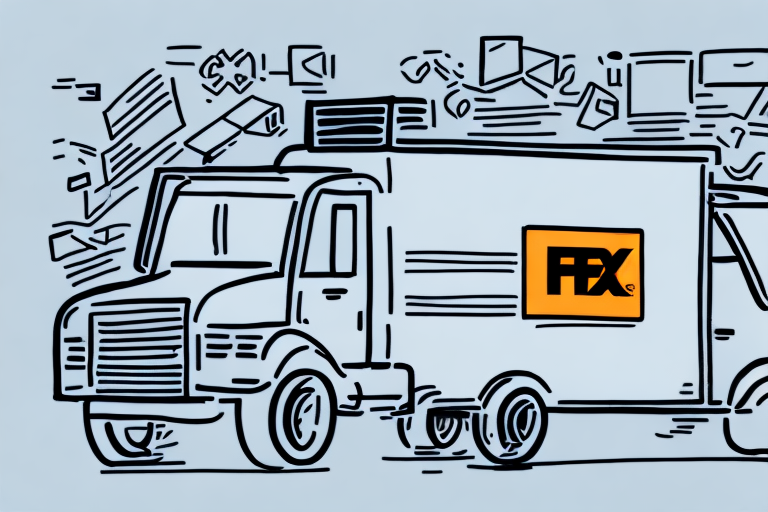Shipping Food with FedEx: A Comprehensive Guide
Shipping food can be challenging, but with FedEx, you can ensure that your packages arrive safely and on time. This guide covers everything you need to know about shipping food with FedEx, including understanding their policies, choosing the right packaging, tracking your shipment, and more. Read on to learn how to effectively ship food items using FedEx’s reliable services.
Why Choose FedEx for Shipping Food?
FedEx is a trusted shipping carrier with extensive experience in transporting a wide variety of items, including perishable food products. Here are some key reasons why FedEx is a preferred choice for shipping food:
- Reliability and Speed: FedEx offers fast and dependable shipping services, ensuring that your food items reach their destination promptly.
- Advanced Tracking: Their sophisticated tracking system allows you to monitor your shipment in real-time, providing updates on its location and estimated delivery time.
- Specialized Packaging: FedEx provides specialized packaging options, such as insulated containers and dry ice, to maintain the temperature and freshness of perishable items.
- Compliance with Regulations: FedEx ensures that your shipments adhere to all applicable regulations, handling and transporting food safely.
According to the FedEx corporate website, the company processes millions of shipments annually, demonstrating their capacity and expertise in handling diverse shipping needs.
Understanding FedEx's Food Shipping Policies
Before shipping food with FedEx, it’s essential to familiarize yourself with their specific policies to ensure compliance and the safe delivery of your items.
Temperature Control Requirements
FedEx has strict guidelines for temperature-sensitive shipments. Depending on the type of food, you may need to use refrigerated or frozen shipping options to maintain the appropriate temperature throughout transit.
Proper Packaging and Labeling
Proper packaging is critical for maintaining the integrity of your food items. FedEx requires that all perishable shipments are securely packaged and clearly labeled with “Perishable” and “Handle with Care” stickers.
Documentation and Permits
When shipping food, especially internationally, you must include all necessary documentation such as a commercial invoice, packing list, and any required permits or licenses. This ensures compliance with customs regulations and facilitates smooth clearance.
For detailed information on shipping regulations, visit the FedEx International Shipping page.
Choosing the Right Packaging for Your Food Shipment
Choosing the appropriate packaging is vital to preserve the quality and safety of your food items during transit.
Insulated Packaging Solutions
Use insulated packaging or coolers with ice packs to maintain the correct temperature for perishable items. FedEx offers a range of insulated containers designed to keep food fresh.
Sturdy and Leak-Proof Materials
Select packaging that is sturdy and leak-proof to prevent spills and damage. Ensure that the containers are appropriately sized to minimize shifting during transit.
Food-Specific Packaging Considerations
The type of food you are shipping dictates specific packaging needs. For instance:
- Baked Goods: Use packaging that allows for air circulation to prevent moisture buildup.
- Liquids: Utilize containers specifically designed to prevent leaks and spills.
Shipping Method and Duration
Consider the shipping duration and method when selecting packaging. For longer transit times, opt for additional insulation or cooling measures to ensure food remains fresh. For international shipments, verify that your packaging complies with destination country regulations.
Properly Packing and Labeling Your Food Shipment
Proper packing and labeling are essential to ensure that your food items arrive in good condition and are handled correctly during transit.
Secure Packing Techniques
Pack food items securely in your chosen containers, leaving enough space for ice packs or insulated padding. This helps maintain temperature and prevents movement that could cause damage.
Clear and Accurate Labeling
Label your packages clearly with indicators such as “Perishable” and “Handle with Care.” This alerts FedEx personnel to treat the shipment with the necessary precautions.
Special Handling Instructions
Include any special handling instructions, especially for frozen items needing dry ice. Ensure that dry ice is packed in compliance with FedEx regulations.
Choosing the Right Shipping Method
Select expedited shipping options for long-distance or international shipments to minimize transit time and reduce the risk of spoilage. Always track your shipment to stay informed about its progress.
Ensuring Freshness and Safety During Transit
Maintaining the freshness and safety of your food shipments involves several best practices:
Use Expedited Shipping Services
Opt for overnight or two-day delivery services to reduce the time your food spends in transit, minimizing the risk of spoilage.
Temperature-Controlled Shipping Options
For items requiring refrigeration or freezing, utilize FedEx’s temperature-controlled shipping services to maintain the necessary conditions throughout the journey.
Proper Packaging Materials
Use high-quality insulated packaging and reliable ice packs to keep perishable items at the right temperature. Ensure all seals are tight to prevent leaks and contamination.
Monitor Your Shipment
Regularly track your shipment using FedEx’s online tracking system. This allows you to anticipate any delays and take corrective action if necessary.
Common Mistakes to Avoid When Shipping Food with FedEx
Avoid these common pitfalls to ensure your food shipments are successful:
- Inadequate Packaging: Using inappropriate or insufficient packaging can lead to damage and spoilage.
- Poor Labeling: Failing to label packages correctly may result in mishandling during transit.
- Ignoring Insulation Needs: Not using proper insulation or refrigeration can compromise the quality of perishable items.
- Incorrect Shipping Speed: Selecting a shipping option that doesn’t align with the perishability of the food can cause delays and spoilage.
- Overlooking Prohibited Items: Shipping restricted foods without proper permits can lead to shipment delays or confiscation.
For a complete list of prohibited items, refer to the FedEx Prohibited and Restricted Items page.
Tracking Your Food Shipment for Timely Delivery
Effective tracking ensures that you stay informed about the status of your food shipment and can address any issues promptly.
Using FedEx's Tracking System
Enter your tracking number on the FedEx Tracking Page to monitor your package’s progress in real-time.
Signature Confirmation
Opt for signature confirmation to ensure that your package is delivered directly to the recipient, reducing the risk of loss or mishandling.
Accurate Shipping Information
Provide precise shipping and delivery details to avoid delays caused by incorrect addresses or contact information.
Handling Potential Delays or Issues During Transit
Despite careful planning, unforeseen delays or issues may arise. Here's how to handle them:
Contacting FedEx Customer Service
If your shipment is delayed or doesn't arrive on time, reach out to FedEx Customer Service to resolve the issue promptly.
Purchasing Shipping Insurance
Consider purchasing shipping insurance to protect your shipment against damage or loss, providing peace of mind during transit.
Compliance with Shipping Regulations
Ensure your shipment complies with all relevant regulations to prevent delays or confiscation. Check the FedEx International Shipping page for detailed guidelines.
International Food Shipping with FedEx: What You Need to Know
Shipping food internationally involves additional considerations to comply with various countries' regulations and ensure safe delivery.
Understanding Import Regulations
Different countries have specific import regulations regarding food items. Before shipping, verify the destination country's rules to ensure your shipment is allowed.
Required Permits and Certifications
Certain food items, such as meat, dairy, and fresh produce, may require special permits or certifications for international shipping. Consult with FedEx or the destination country's customs office to obtain necessary documentation.
Using FedEx's International Shipping Services
FedEx offers specialized international shipping services that cater to perishable items, ensuring compliance and maintaining food quality during transit. Visit the FedEx International Shipping page for more information.
Cost Considerations When Shipping Food with FedEx
The cost of shipping food with FedEx depends on several factors. Understanding these can help you choose the most cost-effective option:
- Package Weight and Size: Heavier and larger packages incur higher shipping fees.
- Shipping Speed: Expedited shipping options, such as overnight or two-day delivery, are more expensive than standard shipping.
- Additional Services: Services like refrigeration, dry ice, and shipping insurance add to the overall cost.
- Destination: International shipping generally costs more than domestic shipping due to customs and transportation fees.
To estimate shipping costs, use the FedEx Rate Calculator.
Using Special Services Like Refrigerated or Frozen Shipping
For food items that require temperature control, FedEx offers specialized services to maintain the necessary conditions during transit.
Refrigerated Shipping
FedEx's refrigerated shipping services ensure that perishable items remain at the desired temperature, preventing spoilage and maintaining freshness.
Frozen Shipping
For items that need to stay frozen, FedEx provides frozen shipping options that utilize dry ice and other cooling methods to keep products solid throughout the journey.
Specialized Packaging and Handling
These services include the use of insulated packaging and temperature monitoring to ensure that food items remain within safe temperature ranges.
Learn more about FedEx's temperature-controlled shipping options.
Handling Returns or Damaged Packages
If your food shipment arrives damaged or the contents are unsatisfactory, prompt action can help resolve the issue.
Contacting FedEx Customer Service
Immediately reach out to FedEx Customer Service to report the damage and initiate a return or exchange process.
Purchasing Shipping Insurance
Shipping insurance provides financial protection against loss or damage, ensuring that you are compensated if your shipment is compromised.
Documenting Damage
Take clear photographs of any damage and retain all packaging and documentation. This evidence will support your insurance claim or refund request.
Best Practices for Repeat or Bulk Food Shipments with FedEx
When handling repeat or bulk shipments, efficiency and consistency are key to maintaining quality and reducing costs.
Setting Up a FedEx Account
Establishing a FedEx account allows you to manage shipments more effectively, access discounts, and utilize advanced shipping tools.
Automated Shipping Tools
Use FedEx’s automated shipping solutions to schedule and track multiple shipments, streamlining your shipping process.
Flat-Rate Shipping Options
Consider FedEx’s flat-rate shipping options for bulk shipments to simplify pricing and potentially reduce costs.
Consistent Packaging Standards
Maintain consistent packaging practices to ensure that all bulk or repeat shipments meet FedEx’s requirements and safeguard the quality of your food items.
Conclusion
By following these guidelines, you can ensure that your food shipments arrive safely, fresh, and on time with FedEx. Proper understanding of FedEx’s shipping policies, effective packaging, and utilizing their specialized services are crucial to successful food shipping. For more information on shipping food with FedEx, visit their Food Shipping Page or contact their customer service for personalized assistance.






















